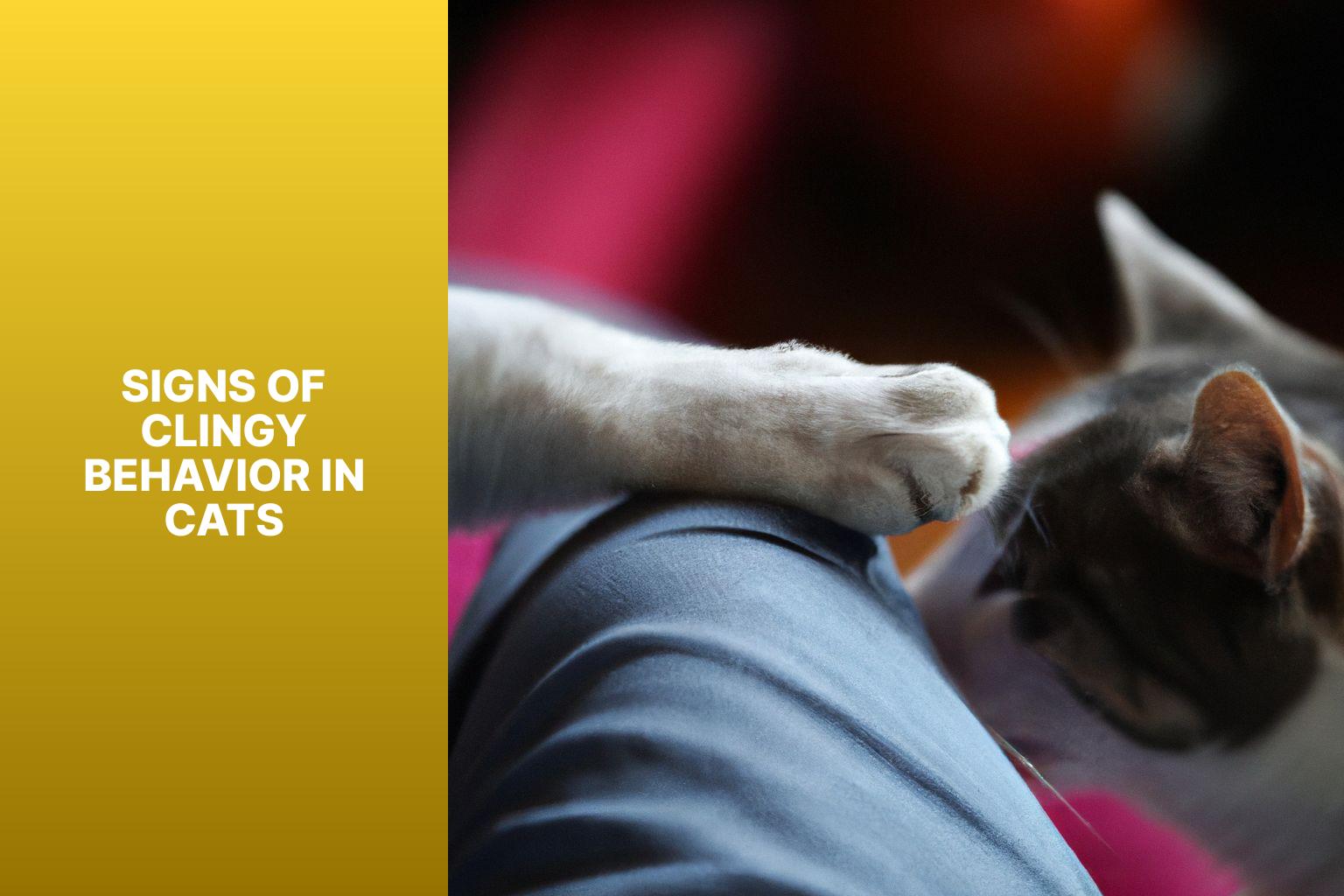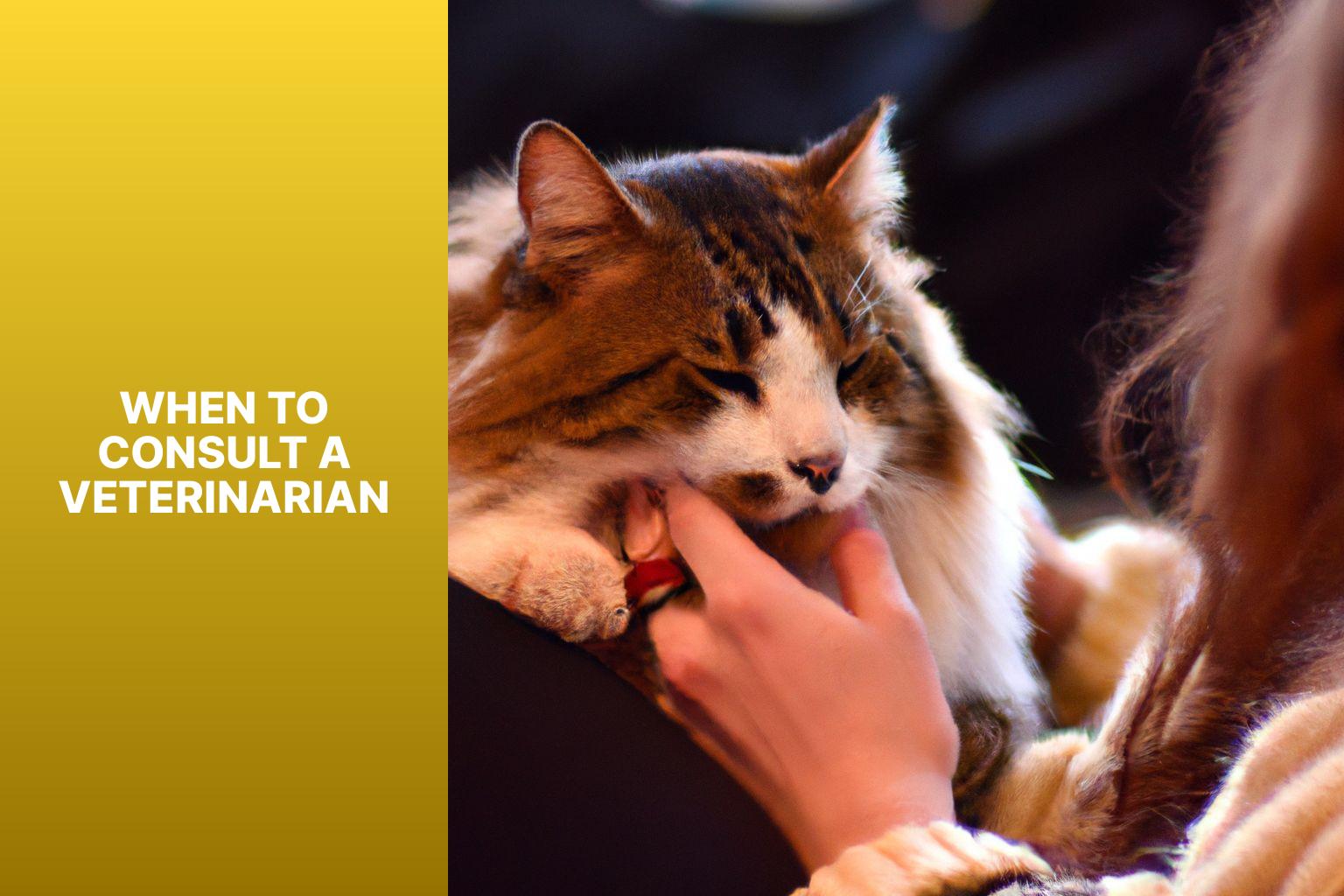Cats, known for their independent nature, can sometimes exhibit clingy behavior, which can be puzzling for their owners. Understanding why your cat is being clingy is essential in addressing their needs and ensuring their well-being.
There are several reasons why cats may become clingy, including their need for attention and affection. Cats are social creatures and crave human interaction. Separation anxiety can also cause clinginess, particularly if your cat becomes upset when you leave the house. Health issues or changes in their environment can trigger clingy behavior in cats.
Recognizing the signs of clingy behavior is crucial in identifying whether your cat is being excessively needy. These signs may include following you around constantly, excessive vocalization or meowing, demanding attention through scratching or pawing, and exhibiting anxious behavior when you’re not around.
Dealing with a clingy cat requires patience and understanding. Providing adequate attention and affection is important, ensuring that your cat feels loved and secure. Establishing a routine can also help create a sense of stability for your cat. Creating a safe and enriching environment, including interactive toys and scratching posts, can help alleviate clingy behavior. Gradually training your cat to become more independent can help reduce clinginess over time.
If your cat’s clingy behavior becomes excessive or is accompanied by other concerning symptoms, it’s essential to consult a veterinarian. They can rule out any underlying medical conditions and provide appropriate guidance to help address your cat’s clingy behavior effectively.
By understanding clingy behavior in cats, being responsive to their needs, and providing a nurturing environment, you can help your feline friend feel more secure and content.
Key takeaway:
- Understanding Clingy Behavior in Cats: Clingy behavior in cats can stem from various reasons such as the need for attention, separation anxiety, health issues, or environmental changes.
- Signs of Clingy Behavior in Cats: Some signs of clingy behavior in cats include constantly seeking attention, following their owners around, or displaying anxious behavior when left alone.
- Dealing with a Clingy Cat: Providing adequate attention and affection, establishing a routine, creating a safe and enriching environment, and gradually training for independence can help manage clingy behavior in cats.
Understanding Clingy Behavior in Cats
Understanding Clingy Behavior in Cats
Cats may display clingy behavior due to their social needs, anxiety, stress, or medical issues. They seek companionship and become clingy when they feel lonely or when their social needs are not met. Changes in their environment or medical conditions such as pain can trigger clinginess. To address this behavior, it is essential to provide social interaction, bond with your cat, establish a routine, and create a calm environment.
If your cat continues to exhibit clingy behavior, it is advisable to consult with a veterinarian for behavioral modifications or pheromone therapy to alleviate anxiety.
In a true story, a friend’s cat named Whiskers became clingy after undergoing surgery. Whiskers would follow her around and meow loudly, indicating pain and discomfort resulting from the surgery. After receiving proper pain management, Whiskers returned to their normal behavior. This story serves as an example that clingy behavior in cats can often signal underlying medical issues.
Reasons Why Cats May Become Clingy
Cats have a reputation for being independent creatures, but have you ever wondered why your beloved feline companion suddenly becomes clingy? In this section, we’ll uncover the reasons behind this behavior. From their need for attention and affection to potential separation anxiety, health issues, and environmental changes, we’ll explore the various factors that can contribute to your cat’s clinginess. So, if you’ve ever found yourself wondering why your cat can’t seem to get enough cuddles, read on to discover the possible explanations lurking behind those adorable whiskers.
Need for Attention and Affection
When it comes to cats, their need for attention and affection is one reason behind their clingy behavior. Cats are social animals and crave interaction with their owners, which is why it is important to consider their need for attention and affection. Here are some factors to keep in mind:
– Cats require daily quality time with their owners to feel loved and secure. This includes playtime, gentle petting, and cuddling.
– If cats feel neglected or ignored, they may become clingy. They seek attention through head rubs, being talked to, or simply being in the same room as their owners.
– Regular bonding activities like grooming sessions or interactive play can strengthen the bond between you and your cat, fulfilling their need for connection.
– It is important to pay attention to your cat’s body language and cues. Signs such as rubbing against your legs, purring, or seeking physical contact indicate their desire for attention and affection.
To address your cat’s need for attention and affection, follow these steps:
– Schedule daily playtime sessions with your cat.
– Set aside specific bonding time for grooming or cuddling.
– Provide environmental enrichment such as puzzle toys or scratching posts to keep them mentally stimulated.
– Maintain a consistent routine to give your cat a sense of security.
Understanding and fulfilling your cat’s need for attention and affection can help reduce clingy behavior and strengthen your bond with your feline companion.
Separation Anxiety
Cats may experience separation anxiety, which occurs when a cat becomes distressed when separated from their owner. Signs of separation anxiety include excessive vocalization, destructive behavior, inappropriate elimination, and self-harming behaviors like excessive grooming or biting.
To address separation anxiety in cats, it is important to provide reassurance and create a sense of security. One way to do this is by establishing a routine to create a predictable environment for the cat. Creating a safe and enriching environment with toys, scratching posts, and hiding places can help alleviate separation anxiety. Gradual independence training can also be beneficial in reducing separation anxiety in cats.
If separation anxiety persists or worsens, it is highly recommended to consult a veterinarian. They can provide guidance and recommend behavior modification techniques or medication to help manage separation anxiety in cats.
It is important to understand that separation anxiety in cats is a common issue. By recognizing the signs and implementing appropriate strategies, we can help our feline friends feel more secure and relaxed when separated from their loved ones.
Health Issues
A cat’s clingy behavior may be influenced by health issues. Some health issues that could contribute to a cat becoming clingy include:
- Pain or Discomfort: Cats may seek extra attention and affection if they are in pain or discomfort. This could be due to conditions such as arthritis, dental problems, or urinary tract issues.
- Hormonal Imbalance: Hyperthyroidism or diabetes can affect a cat’s behavior, leading to clinginess as a way to seek comfort or reassurance.
- Digestive Problems: Cats with gastrointestinal issues like constipation or inflammatory bowel disease may exhibit clingy behavior to seek comfort or communicate that something is wrong.
- Cognitive Decline: Older cats may experience cognitive decline, causing confusion or anxiety. This can result in clingy behavior as they seek reassurance from their owners.
- Side Effects of Medication: Certain medications can cause changes in a cat’s behavior, including clinginess. If your cat is on new medication, monitor their behavior for any changes.
Observing your cat’s behavior and consulting with a veterinarian is crucial if you notice unusual clingy behavior. It could be a sign of an underlying health issue. Prompt veterinary care can help diagnose and address the problem, ensuring your cat’s well-being. Understanding your cat’s health is essential in providing them with the care they need and deserve.
Environmental Changes
Environmental changes can have a significant impact on the behavior of cats and contribute to their clinginess. Cats are highly sensitive creatures that can become anxious and stressed when there are alterations in their surroundings. Moving to a new home, introducing new family members or pets, or even just rearranging furniture can disrupt a cat’s sense of security and routine.
When faced with environmental changes, cats often seek comfort and reassurance from their owners, which can lead to clingy behavior. They may start following their owners around more, vocalizing excessively, or becoming more demanding for attention and affection.
To help cats cope with these changes, it is crucial to provide them with a calm and stable environment. Maintaining a consistent routine and offering familiar hiding spots or safe spaces can make them feel more secure. It is also recommended to introduce any new elements or changes gradually to minimize their stress levels.
Here’s a pro-tip: When making environmental changes, always do so gradually and provide mental and physical stimulation opportunities for your cat. Interactive toys, scratching posts, and perches can help keep them engaged and alleviate any stress caused by the changes.
Signs of Clingy Behavior in Cats
Photo Credits: Www.Catcornerblog.Com by Gabriel Harris
Clingy behavior in cats can indicate a strong attachment to their owners or a possible issue. Here are some signs of clingy behavior in cats to look out for:
– Constantly following you around.
– Excessive meowing or vocalization for attention.
– Refusing to let you out of their sight or invading your personal space.
– Excessive grooming of you or themselves.
– Becoming anxious or distressed when you’re not around.
Clinginess in cats can result from separation anxiety, loneliness, or a medical condition. Observe your cat’s behavior and consult with a veterinarian if you have concerns.
Changes in environment or routine can also cause clingy behavior in cats. Cats rely on owners for stability and reassurance. A consistent routine and enriched environment can help alleviate signs of clingy behavior in cats in some cases.
How to Deal with a Clingy Cat
Feeling suffocated by your cat’s constant need for attention? In this section, we’ll uncover effective strategies to deal with a clingy cat. From providing adequate attention and affection to establishing a routine, creating a safe environment, and gradually fostering independence, we’ve got you covered. Say goodbye to the overwhelming neediness and hello to a balanced and harmonious relationship with your feline friend.
Provide Adequate Attention and Affection
Providing adequate attention and affection to your clingy cat is crucial for their well-being and to address their clingy behavior. To ensure your cat receives the attention they need, follow these tips:
- Spend quality time: Interact and play with your cat every day. Use their favorite toys and engage in interactive play to fulfill their need for attention.
- Give physical affection: Regularly pet and groom your cat to show them love. Brush their fur, provide gentle massages, and give them cuddles.
- Create a comfortable space: Establish a cozy environment where your cat can have alone time. Provide a soft bed, blankets, and a designated space with their favorite toys.
- Establish a routine: Cats thrive on routine, so provide adequate attention and affection to maintain a consistent daily routine. Set specific times for feeding, playtime, and quiet time to provide a sense of security.
- Show love through play: Interactive play sessions strengthen the bond between you and your cat. Use toys like feather wands or laser pointers to keep them entertained.
By consistently providing your cat with adequate attention and affection, their emotional needs will be met and their clingy behavior will be reduced. Remember to observe your cat’s preferences and adjust your approach accordingly, as every cat is unique.
Establish a Routine
Establishing a routine is crucial when it comes to dealing with a clingy cat. By following a consistent schedule, you can provide your cat with the security and stability they need, which will ultimately help reduce their clingy behavior.
To establish a routine, here are some key steps to follow:
1. Feed your cat at the same times every day. This will create a predictable routine that contributes to their overall well-being.
2. Schedule regular play sessions with your cat. Engage them in interactive play using toys that mimic hunting behavior. This will help expel their excess energy and provide mental stimulation, ultimately reducing their need for constant attention.
3. Set aside specific times in the day for quality, uninterrupted time with your cat. This can include cuddling, grooming, or simply sitting together. By providing dedicated attention during these times, your cat will feel reassured and less clingy throughout the day.
4. Ensure your cat has a comfortable and quiet sleeping space. Establish a specific bedtime routine to signal relaxation. You can do this by dimming the lights, playing soothing music, or providing a cozy bed or blanket.
5. Maintain a stable and stress-free environment for your cat. Avoid making frequent changes to their living space, such as moving furniture or introducing new pets. A calm and familiar environment will help ease their anxiety and reduce clingy behavior.
By incorporating these steps and establishing a routine, you can create predictability and structure in your cat’s life. This, in turn, promotes their overall well-being and helps reduce clingy behavior.
Create a Safe and Enriching Environment
Creating a safe and enriching environment is crucial for helping a clingy cat feel secure and content. Here are some ways to create that safe and enriching environment:
-
Provide hiding spots: Cats seek hiding spots when anxious or overwhelmed. Create hiding spots like cat caves or cardboard boxes in different areas of your home. This gives your cat a safe space to retreat to when they need alone time.
-
Vertical space: Cats love climbing and perching on high surfaces. Install cat trees, shelves, or window perches to give your cat opportunities to explore and observe from a higher vantage point. This helps them feel more in control and secure.
-
Environmental enrichment: Keep your cat mentally stimulated with toys, scratching posts, and puzzle feeders. Rotate and introduce new toys regularly to prevent boredom and encourage exploration.
-
Litter box hygiene: Cats are particular about litter boxes, so keep them clean and easily accessible. Provide one litter box per cat plus an extra and place them in quiet areas away from high-traffic zones.
-
Consistent routine: Cats thrive on routine, so establish a predictable schedule for feeding, playtime, and cuddle sessions. This creates stability and reduces anxiety.
-
Positive reinforcement: Reward your cat with praise, treats, or playtime when they display independent behavior and spend time exploring or playing on their own. This builds their confidence and encourages them to seek out enriching activities on their own.
By implementing these measures, you can create a safe and enriching environment that promotes your clingy cat’s well-being and helps them become more independent and self-assured.
Gradual Independence Training
Edited
Gradual Independence Training can help your clingy cat become more self-reliant and confident. Follow these steps:
1. Start with short periods of separation: Leave your cat alone for short periods, gradually increasing the duration. This helps them become accustomed to being alone and reduces reliance on constant human presence.
2. Create a safe space: Set up a designated area with food, water, litter box, and toys. This gives them security and independence in their own space.
3. Provide enriching activities: Offer interactive toys and puzzles to keep your cat mentally stimulated and entertained. This distracts them from seeking constant attention.
4. Establish a routine: Stick to a consistent schedule for feeding, playtime, and alone time. Cats thrive on predictability, reducing anxiety and promoting independence.
5. Encourage independent play: Introduce toys that your cat can play with on their own, such as puzzle feeders or wand toys. This boosts confidence and encourages independent activities.
6. Use positive reinforcement: Reward your cat with treats or praise when they demonstrate independent behavior, such as playing alone or exploring. This reinforces desired behavior and motivates independence.
By following these steps, you can help your clingy cat become more comfortable being alone and develop independence. Remember to be patient and consistent in your training approach.
When to Consult a Veterinarian
Photo Credits: Www.Catcornerblog.Com by Randy Johnson
If you notice concerning behaviors or symptoms in your cat, it is important to consult a veterinarian. Here are specific situations where veterinary care is necessary:
1. Persistent vomiting or diarrhea: If your cat experiences frequent or prolonged episodes of vomiting or diarrhea, it may indicate an underlying health issue. A veterinarian can determine the cause and provide appropriate treatment.
2. Difficulty urinating: If your cat is straining to urinate or not urinating at all, it could be a sign of a urinary tract infection or blockage. This requires immediate veterinary care.
3. Changes in appetite or weight loss: If your cat suddenly loses interest in food or experiences unexplained weight loss, it could be a sign of an underlying medical condition. A veterinarian can diagnose the issue with necessary tests and provide proper treatment.
4. Behavioral changes: Significant changes in behavior, such as increased aggression, sudden lethargy, or excessive vocalization, may indicate discomfort or illness. It is essential to consult a veterinarian who can assess the behavior and provide appropriate advice or treatment.
5. Persistent coughing or difficulty breathing: Respiratory issues in cats should never be ignored. If your cat is coughing, wheezing, or experiencing difficulty breathing, it could be a sign of a respiratory infection, asthma, or other conditions. A veterinarian can evaluate the respiratory system and provide suitable treatment.
Remember, early veterinary intervention is crucial for your cat’s well-being. If you notice any concerning signs or symptoms, make sure to promptly consult a veterinarian.
Some Facts About Why Cats Can Be Clingy:
- ✅ Cats can exhibit clingy behavior, such as following their owners everywhere, getting upset when left alone, and being jealous when attention is given to others. (Source: pethonesty.com)
- ✅ Clingy cats always want to be near their owners, head-butt or rub against them, purr loudly when petted, and sleep on top of them. (Source: pethonesty.com)
- ✅ Clingy behavior in cats can be caused by lack of socialization, fearfulness, separation anxiety, lack of exercise, health problems, old age, boredom, and poor nutrition. (Source: pethonesty.com)
- ✅ Signs of clinginess in cats include following you everywhere, constantly wanting to be on you, meowing for attention, demanding affection, refusing to eat when you’re not there, acting shy around visitors, sulking or hiding when you’re leaving, getting overly excited when you return home, and exhibiting destructive behavior. (Source: hillspet.com)
- ✅ Clinginess in cats can be caused by boredom, premature weaning and separation anxiety, insecurity due to changes in routine or environment, wanting to provide comfort to their owners, sensing pregnancy in women, lack of enforced boundaries, and underlying health issues. (Source: hillspet.com)




